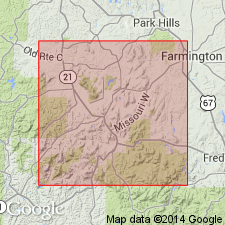
- Usage in publication:
-
- Pilot Knob felsite
- Modifications:
-
- First used
- Dominant lithology:
-
- [Felsite]
- AAPG geologic province:
-
- Midcontinent region
Summary:
Pilot Knob felsite (new) of Middlebrook group (new). Briefly summarized in report by W.C. Hayes, Precambrian rock units in Missouri, p. 83 (table 1), this volume. New names are credited to Tolman and Robertson (in prep.) [1969, Missouri Div. Geol. Survey Water Res. Rpt. Inv., no. 44 (Contrib. to Precambrian Geol., no. 1)]. Age is Precambrian.
Occurs in St. Francois Mountain area. Pilot Knob is in T. 34 N., R. 4 E., Iron Co., southeastern MO.
Source: Modified from US geologic names lexicon (USGS Bull. 1350, p. 577).
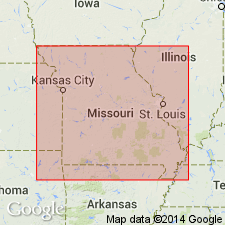
- Usage in publication:
-
- Pilot Knob felsite
- Modifications:
-
- Geochronologic dating
- AAPG geologic province:
-
- Midcontinent region
Summary:
Whole rock Rb-Sr age determined to be 1420 +/-30 m.y. Study area in St. Francois Mountains, southeast MO, Midcontinent region. Other units having same Rb-Sr age as Pilot Knob include Hogan Mountain and Royal Gorge rhyolites and rhyolite of Johnson Shut-ins. Older than Munger granite porphyry and Magee granite (1260 +/-30 m.y.) and Stout's Creek rhyolite (1315 +/-35 m.y.). Age similar to Silvermine and Butler Hill granites (1400-1450 m.y.).
Source: GNU records (USGS DDS-6; Denver GNULEX).

- Usage in publication:
-
- Pilot Knob felsite
- Modifications:
-
- Principal reference
- Dominant lithology:
-
- Volcanics
- AAPG geologic province:
-
- Midcontinent region
Summary:
Pilot Knob felsite of Middlebrook group. Present in St. Francois Mountains, Iron County, southeastern Missouri, notably on Pilot Knob, Oak Mountain, Anderson Mountain, Shepard Mountain, and Cedar Hill. At Pilot Knob, is a dark reddish-brown to dull purple-gray felsite; rocks are poorly exposed on slopes and mixed with dump material from many workings. Annealed breccia fragments present in most hand specimens. Contains light-red feldspar phenocrysts that are characteristic of the rock, and small, subhedral quartz phenocrysts. Lies below Ketcherside tuff, [separated by an erosional unconformity?]. At Cedar Hill, underlies Oak Mountain rhyolite of Middlebrook group. Age is Precambrian.
Typically exposed on Pilot Knob, in sec. 29, T. 34 N., R. 4 E., Iron Co., southeastern MO. Origin of name not stated by authors, but probably named from Pilot Knob.
[GNU remark (Feb. 16, 1990, USGS DDS-6; Denver GNULEX): Stratigraphic relationships of units of Middlebrook not discussed in text; geologic map (plate 1) missing from library copy of report.]
Source: Modified from GNU records (USGS DDS-6; Denver GNULEX).
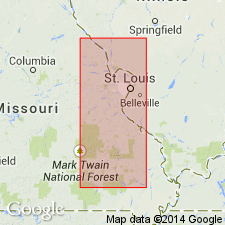
- Usage in publication:
-
- Pilot Knob Felsite
- Modifications:
-
- Geochronologic dating
- AAPG geologic province:
-
- Midcontinent region
Summary:
Rb-Sr age of 1366 +/-50 m.y. Sample from St. Francois Mountains, southeast MO, Midcontinent region.
Source: GNU records (USGS DDS-6; Denver GNULEX).
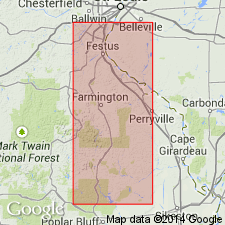
- Usage in publication:
-
- Pilot Knob Felsite
- Modifications:
-
- Not used
Summary:
Pilot Knob Felsite. Not used in western St. Francois Mountains, southeast Missouri (Midcontinent region). Replaced with newly named formations (alphabetical): Cedar Bluff Rhyolite (Shepherd Mountain); and Shepherd Mountain Rhyolite, which is petrographically different from rock of Pilot Knob (Shepherd Mountain).
Source: Modified from GNU records (USGS DDS-6; Denver GNULEX).
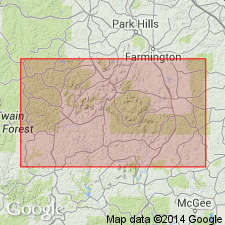
- Usage in publication:
-
- Pilot Knob felsite
- Modifications:
-
- Areal extent
- Revised
- Overview
- AAPG geologic province:
-
- Midcontinent region
Summary:
Restricted to northwest part of quad in Iron Co, MO, Midcontinent region. Areas previously mapped by Tolman and Robertson (1969) as Pilot Knob include units now mapped as the newly named and informal Grassy Mountain ignimbrite and Lake Killarney unit. Is youngest volcanic unit in quad. Unconformably overlies Grassy Mountain ignimbrite; older than intrusive rocks. Thickness estimated to be 150-350 m. Petrographic data on two samples; generalized geologic map. Unit is probably a sequence of rhyolitic flows. Precambrian age.
Source: GNU records (USGS DDS-6; Denver GNULEX).
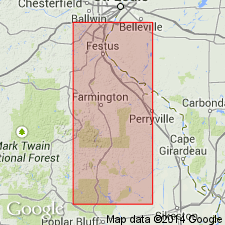
- Usage in publication:
-
- Pilot Knob Felsite
- Modifications:
-
- Revised
- AAPG geologic province:
-
- Midcontinent region
Summary:
Pilot Knob Felsite, uppermost formation (of 3) of /Butler Hill Group of /St. Francois Mountains Volcanic Supergroup (revised). [Previously assigned to Middlebrook Group by Tolman and Robertson (1969); status of Middlebrook not discussed.] Study area is St. Francois Mountains, southeast Missouri (Midcontinent region). Younger than Grassy Mountain Ignimbrite (revised) of Butler Hill; older than Shepherd Mountain Rhyolite (revised) of /Taum Sauk Group (new) of St. Francois Mountains Volcanic Supergroup. Age is Precambrian Y. Nomenclature listed in table 1.
[Conflicts with nomenclature guidelines (ACSN, 1970; NACSN, 1983, 2005, 2021): name Butler Hill applied concurrently to two different units in same area; preempted by Butler Hill Granite of Tolman and Robertson (1969); name St. Francois Mountains applied concurrently to two different units in same area; a [supergroup] name combines a geographic name with the term ["supergroup,"] and no lithic designation is included; name Taum Sauk used for both group and formation within it (Taum Sauk Rhyolite has priority).]
Source: Modified from GNU records (USGS DDS-6; Denver GNULEX).
For more information, please contact Nancy Stamm, Geologic Names Committee Secretary.
Asterisk (*) indicates published by U.S. Geological Survey authors.
"No current usage" (†) implies that a name has been abandoned or has fallen into disuse. Former usage and, if known, replacement name given in parentheses ( ).
Slash (/) indicates name conflicts with nomenclatural guidelines (CSN, 1933; ACSN, 1961, 1970; NACSN, 1983, 2005, 2021). May be explained within brackets ([ ]).

